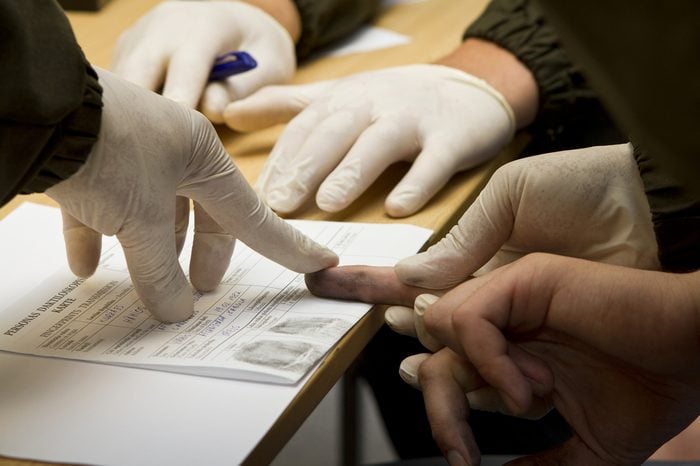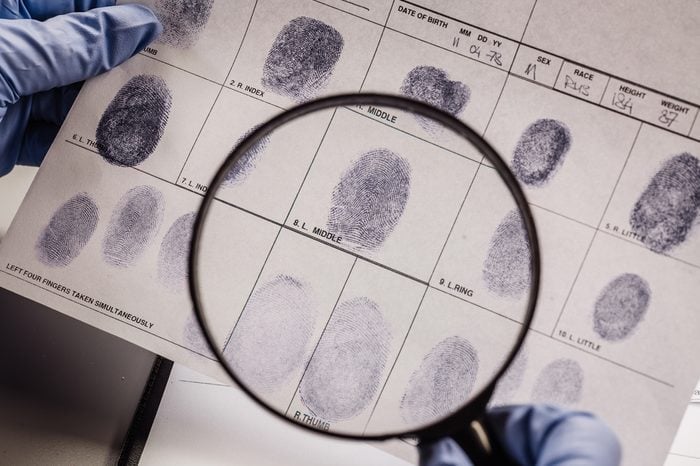
Where is the real Paul Fronczak?
In 1964, one-day-old Paul Fronczak was kidnapped from the Chicago hospital where he was born. Two years later, the FBI believed they had found him abandoned in a shopping mall and returned him to his parents—the physical characteristics of the recovered infant matched the one picture of the newborn Paul. But in 2012, DNA testing revealed Paul was not the son of his parents after all. Further investigation revealed he was born Jack Rosenthal, a full six months before the real Paul Fronczak was born. What forensics has not yet revealed, however, is: what happened to the real Paul Fronczak? Here are 16 of history’s strangest unsolved mysteries.

…and where is Jill Rosenthal?
In 2015, the man who believed he was Paul Fronczak but was actually Jack Rosenthal reconnected with his biological family, who revealed that Jack was one of four siblings, all of whom had been neglected by their parents (the parents were now deceased). Even more upsetting, Jack was born a twin, but his twin sister Jill had also gone missing as a child—and she has yet to be found. So far, Jill’s DNA hasn’t turned up in any databases, and the question remains: What happened to Jill Rosenthal? All six of these missing person mysteries actually ended up getting solved.

Orlando and Brandon Nembhard: identity crisis
The case of Orlando and Brandon Nembhard illustrates that forensic evidence is only as good as the technology used to analyze it. In 2011, witnesses claimed they saw Orlando brandish a pistol and shoot a young man dead outside a nightclub in Chandler, AZ. It would have been an open-and-shut case, except that Orlando’s identical twin, Brandon, was also present at the crime scene. No forensic evidence from the crime could reveal which brother was responsible, and police had to drop the case.

Patrick and James Hennessy: identity crisis redux
Five years after one or both of the Nembhard twins got away with murder, Patrick Hennessy, accused of reckless behavior behind the wheel of a car in the United Kingdom in 2016, managed to wriggle out of the charges because prosecutors were unable to distinguish between the DNA of Patrick and his identical twin, James, whom Patrick claimed was really the one driving the car.

What killed the Logue sisters?
On a summer day in 1974, Angelina and Debora Logue (ages 7 and 4) were spending the afternoon at their aunt’s swimming pool in Long Island, New York. Out of nowhere, the girls fell ill, lapsed into comas, and died soon after. But from what? No toxin or organism was ever identified, despite sophisticated tissue analysis. “Something killed those girls. I wish I knew what it was,” the New York Times quoted the Medical Examiner, Sidney Weinberg, MD. Weinberg died in 1996, and the mystery remains unsolved. Find out the crimes that will never get solved.

What killed Kim Jong Nam?
On February 13, 2017, Kim Jong Nam, half-brother of the North Korean president Kim Jong Un, was murdered in a Malaysian airport. A woman ambushed him and rubbed something in Nam’s face before scurrying away, and Nam collapsed and died en route to the hospital. While the toxic substance is believed to have been nerve gas, its precise identity remains elusive. “The more unusual, the more potent, the more volatile a poison is, the less likely it is to be detected,” explains Australian toxicologist, Olif Drummer.

Who really assaulted the Central Park Jogger?
Looks like we’ll never know for sure what really happened that night in 1989 when the Central Park jogger was assaulted and left for dead. Five teenagers—”Central Park Five”—were rounded up as suspects, but none of their DNA matched the crime’s DNA evidence. Nevertheless, the jury convicted each of the Central Park Five based on circumstantial evidence, and all five were imprisoned until 2002, when another man, Matias Reyes, confessed to the crime. Law enforcement claimed his DNA was a match, but Reyes will never stand trial because the statute of limitations has expired. These medical mysteries still stump doctors.

Who murdered Louise Talley?
Anthony Wright served more than 20 years in prison for the 1991 rape and murder of 77-year-old Louise Talley before he managed to convince a judge to re-examine the original forensic evidence. Upon re-examination, it was found the DNA evidence matched that of another man, Ronnie Byrd. Wright was exonerated, but because Byrd was already dead, the new evidence will never be scrutinized at trial.

The murder of Meredith Kercher
In 2007, Meredith Kercher, an American college student studying in Italy, was fatally stabbed in her apartment. Trace amounts of the DNA of her roommate, Amanda Knox, and Amanda’s boyfriend were found at the scene and on the knife that was presumed to be the weapon. Despite the fact that another man’s fingerprints and DNA were found at the scene—and that the knife couldn’t have been the weapon (it didn’t have Meredith’s DNA on it)—Amanda and her boyfriend were convicted. In 2015, after a lengthy appeal process, the two were exonerated.

The poisoning of Urooj Khan
In 2012, Urooj Khan won a million dollars with a lottery a ticket he purchased at a 7-Eleven near his home in Chicago. But before he had a chance to collect his winnings, he died. It was presumed the 46-year-old had died of natural causes—until the medical examiner discovered that Khan had been poisoned with cyanide. But no one has ever been able to connect the poisoning and anyone with a motive. The case remains unsolved.

John Schneeberger’s bad blood
For years, a female patient claimed that John Schneeberger, a physician in Saskatchewan, Canada, had drugged and raped her in 1992. But repeated DNA tests failed to match the sperm sample from her underwear. The patient hired a private eye to obtain DNA samples from Schneeberger’s car—which proved to be a match. Investigators brought Schneeberger back in for more extensive tests and were finally able to get a match and reach a conviction (he was also convicted of drugging and raping his step-daughter). At trial, Schneeberger revealed how he had been able to fool the DNA exam: He had implanted a vial of another man’s blood in his bicep and tricked the nurse into drawing blood from that vial.

The Zodiac Killer
The Zodiac Killer murdered a number of people in the San Francisco Bay area in the 1960s and early 1970s and has never been caught—but not for lack of forensic evidence. Zodiac, as he called himself, left behind fingerprints and handprints at his crime scenes and on the taunting letters he sent to law enforcement. The text of the letters, themselves provided forensic evidence as well. And while several people have claimed to be the Zodiac, they don’t match the forensic evidence from the killings.

Who really murdered Kathy Mabry?
In 1997, Kathy Mabry was found murdered in an abandoned house in Belzoni, Mississippi. Law enforcement attempted to use the bite marks found on her body in the same way they’d use fingerprints—to identify a suspect. Bite mark identification—a controversial forensic technique—led the police to James Earl Gates, whom they arrested despite the lack of any other evidence connecting him to the crime. The jury acquitted Gates, and the real murderer has never been found. Read up on the strangest unsolved mysteries in each state.

The Theater Shooter’s motive
Not all forensic science involves evidence you can see or touch. For example, forensic psychology involves figuring out a criminal’s motive and state of mind. That’s what William H. Reid, MD, tried to do when he was called in to consult on the mass murder trial of James Holmes, who killed 12 people and wounded 58 more during a showing of The Dark Night Rises on July 20, 2012. But even after interviewing Holmes for a total of 24 hours over a period of two months, Dr. Reid has concluded that Holmes’ motives are almost certainly incapable of ever being known or understood.

The “Dr. X” killings
Sometimes even seemingly airtight forensic evidence is insufficient to convince a jury. That’s how Mario Jascalevich, a surgeon who always seemed to be “around” when other doctors’ patients died inexplicably following routine surgeries, apparently got away with the murder in 1975. Although an investigation revealed the doctor’s locker held 18 empty bottles of the poison curare—which was shown to be in the bodies of the victims—the jury chose to believe the doctor’s claims that he’d used the curare to conduct experiments on dogs. The patients’ deaths remain unsolved to this day.

The Black Dahlia
Elizabeth Short, an aspiring actress, was brutally murdered in Los Angeles in 1947. The LAPD conducted a lengthy, high-profile investigation, but a lack of forensic evidence (beyond the mutilated body, itself) left the detectives empty-handed. “Today, the Black Dahlia murder remains one of the oldest cold case files in L.A., as well as the city’s most famous,” according to Biography. Researchers still can’t explain these ancient mysteries.

Santae Tribble: The “hair of the dog”
In 1978, when 17-year-old Santae Tribble was in the crosshairs of law enforcement for the murder of a cab driver in Washington, DC, FBI forensics experts matched a strand of hair recovered at the scene to Tribble’s hair (this was prior to DNA testing). Based on that evidence alone, the jury came back with a guilty verdict after 40 minutes of deliberation. The only problem? The hair wasn’t Tribble’s. In fact, it wasn’t even human. In 2012, a review of the evidence revealed the hair came from a dog. Tribble was exonerated. McCormick’s murder has not been solved.

The mystery of the Somerton Man
On December 1, 1948, a dead man turned up on a beach in Australia. He was fully dressed, and the crime scene was rife with forensic evidence: a half-smoked cigarette, a bus ticket, two combs, a pack of gum, and a piece of paper that had been cut from a book. But since no one ever came forward to identify the body, he became known as the “Somerton Man.” No one ever filed a missing person report that fit his description and the case went cold (despite that the book from which the paper had been cut was eventually found; it yielded nothing but further questions). It’s hoped that advances in forensic science will someday point to the Somerton Man’s identity. These are the strangest unsolved mysteries of all time.

JonBenet Ramsey
The morning of December 26, 1996, JonBenet Ramsey’s mother, Patsy, reported that JonBenet was missing from their Boulder, CO home, and there was a ransom note demanding $118,000 in cash. A few hours later, JonBenet’s father, John, discovered the six-year old’s body in the basement. She’d been strangled. “Boulder police processed more than 1,500 pieces of evidence and interviewed more than 1,000 people in connection with the case,” reports the Los Angeles Times, but the case has never been solved. Why? Authorities blame it not on the forensic evidence, itself, but the way the crime scene and house were handled—or more to the point, improperly secured. Friends and relatives were in the house throughout the search and John, upon finding JonBenet, removed duct tape from her mouth and carried her upstairs, compromising the collection of forensic evidence.

The trouble with timing
In murder cases, establishing the time of death can be a crucial first step in piecing together what happened. The science on establishing the time of death is vast and well-established. But a recent study out of Australia’s “body farm” challenges the current state of time-of-death science. What the study found is that in dry climates (for example, the climate in Sydney), human remains can mummify rather than decompose. That revelation casts significant doubt upon the conventional methods investigators use in establishing time of death—though it may also help solve some cold cases. Next, find out the most notorious criminals in every state.
